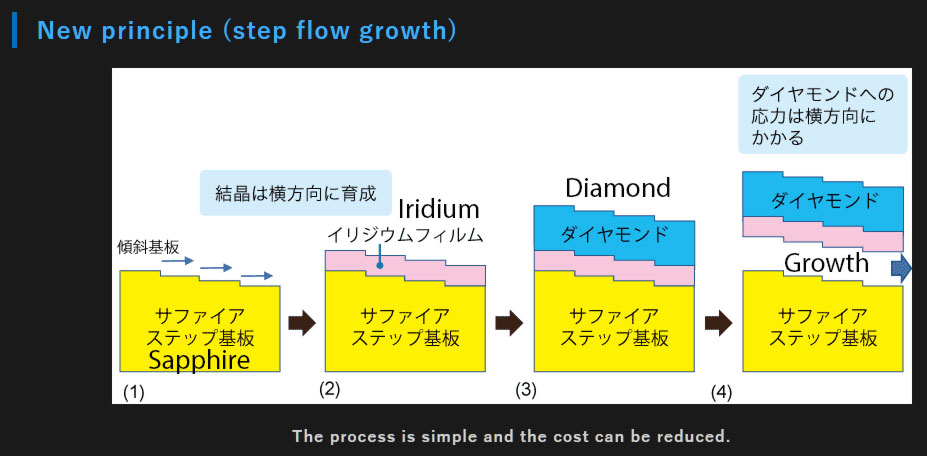Breakthrough Allows for Mass Production of 25 Exabyte 2-Inch Diamond Wafers
A Japanese firm with its roots in the jewelry industry, working alongside academic researchers, has developed a new way to mass produce 2-inch diamond wafers. Importantly, these 'Kenzan Diamonds' are of high enough purity to be useful in applications such as quantum computing. According to the source, a single one of these 2-inch diamond wafers can be used to store the equivalent of a billion Blu-Ray discs.
Adamant Namiki Precision Jewelry Co., Ltd collaborated on this diamond wafer mass production technology with Saga University in Kyushu. Previous diamond wafers with the requisite purity for quantum computing applications were severely limited in size. According to the source, it previously wasn't possible to grow them larger than a 4mm square. Previous attempts to grow 2-inch wafers (~55mm diameter) resulted in levels of nitrogen impurities that rendered the wafers of little or no use to the computing industry.
The mass production breakthrough appears to come from the application of following technique. Diamonds are grown on a sapphire substrate coated with an iridium film, using the principle of 'step flow growth', rather than using diamond micro-needle seeding. The substrates used by the new technique and the stepped structure allow the growth of the diamond under high temperatures and pressures, without any stress cracks upon cool-down. This method of wafer growth also minimizes the absorption of nitrogen, so it is beneath 3 billionths of a percent.
The size and low-nitrogen nature of the new wafers makes them useful for quantum storage applications. Using a 2-inch diamond wafer for quantum storage facilitates the storing of up to a billion Blu-Ray discs full of data. It is also equivalent to the amount of data transmitted by mobile networks in a typical day. From our calculations, this means a single diamond disc can store up to 25 Exabytes of data.
Adamant Namiki Precision Jewelry plans to commercialize Kenzan Diamond wafers in 2023. It is already working of the development of 4-inch diamond wafers.
Diamonds have some uniquely appealing qualities for electronics purposes. Last month we reported on another breakthrough by Japanese scientists, who used diamonds to create transistors with great appeal for low-loss power conversion and high-speed communication components.
Get Tom's Hardware's best news and in-depth reviews, straight to your inbox.

Mark Tyson is a news editor at Tom's Hardware. He enjoys covering the full breadth of PC tech; from business and semiconductor design to products approaching the edge of reason.
-
gggplaya No mention of long term storage? Can this be used to archive data? Companies want a good way to store their data for hundreds of years, current long term media is very limited in storage capacity.Reply -
Giroro Why does Quantum computing need so much storage?Reply
Is Quantum storage different than regular storage?
Can this technology be used for regular computer storage?
What is the storage density/capacity of a silicon wafer of this size?
What kind of storage is this? ReWritable? WORM? -
lol, great now they can store all mobile network traffic every day for eternity... big brother is watching--and will be watching even more now with this techReply
-
jkflipflop98 A couple of my engineers were messing around a while back with a atomic layer deposition tool in the factory and they managed to make a massive 12 inch diamond that was atomically perfect.Reply -
hermitboy ReplyMasterMadBones said:The difference between 2 inches and 55mm is quite significant. Which is it?
The difference comes from the fact that the previous versions could only be 4mm - the 2" listed is said to be 55mm
So the comparison is between 4mm and 55mm, not 2" and 55mm (which is functionally equal) -
RodroX ReplyGiroro said:Why does Quantum computing need so much storage?Is Quantum storage different than regular storage?
Can this technology be used for regular computer storage?
What is the storage density/capacity of a silicon wafer of this size?
What kind of storage is this? ReWritable? WORM?
Probably because of the amount of data it can process in time. You will need a huge chunk of storage to feed new data to the quantum processor.
But Im not expert, so perhaps someone else can share more accurate info/explanation. -
MasterMadBones Reply
It's a near 10% difference. In no situation is that functionally equal in engineering terms.hermitboy said:So the comparison is between 4mm and 55mm, not 2" and 55mm (which is functionally equal)
